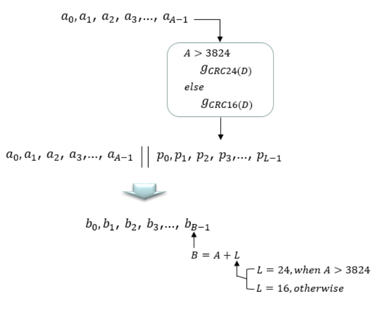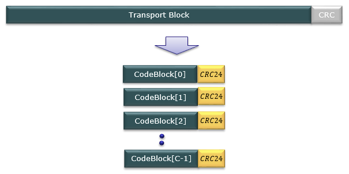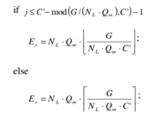CRC attachment
[trBlkCrc, trBlkCrcLen] = pdschCrcEncode(data)
TB 和 CRC生成多项式进行二进制除法相除所得到的余数为CRC部分(没有进位,使用XOR来代替减法)。主要用来检测或校验数据传输后可能出现的错误。在CB级的CRC校验之后再对TB级的CRC进行验证,提高了正确率。
经过研究发现,在原有的TB - CRC 处理的基础上,在每个CB 上分别添加CRC校验信息可以降低译码的复杂度,减小所需的译码延时及缓存器的大小,从而提高接收机连续传输处理能力,支持LTE系统的高速率传输,并且可以加快接收机的处理速度,实现快速的HARQ。采用这种双层CRC 结构,接收端就可以在发现1 个CB 译码错误后停止译码,马上要求重传,而不需要等待整个TB 译码完毕再反馈NACK,从而不仅避免了后续CB 译码的无谓功率消耗,而且节省了处理时间,减小了HARQ 重传时延,可以提高单位时间内的系统吞吐量 (曹型兵, 杨高进, 余利成. TD-LTE中基于码块分割的CRC模块研究与设计[J]. 山西电子技术, 2012(4):51-54.)
pdsch中用到的生成多项式:
- gCRC24A (D)=[D24 +D23 +D18 +D17 +D14 +D11 +D10 +D7 +D6 +D5 +D4 +D3 +D+1] L = 24;
- gCRC16 (D)=[D16 + D12 + D5 +1] L =16;
trBlkLen > 3824,生成多项式选用CRC24A,否则选用CRC16。
- gCRC24B(D)=[D24 +D23 +D6 +D5 +D+1] L=24;
codeblocksegement 中每个CB进行CRC时使用多项式24B。
TB级CRC流程如下:

LDPC编码设计
为了能支持IR-HARQ、以及适用于各种块大小和不同的码率,LDPC码在编码时需要可调节的设计。编码时,校验矩阵H会根据基本图BG(2个)和lifting size(Z 范围2~384)生成,这两个参数会根据码块大小、码率来选取。同一幅基本图多个Z值的设计使得编码可以适用于多种码长,并且这样的设计便于将计算分解为更多的较小的独立原子单元,因此,可以在硬件中更有效地实现更大的并行性。
校验矩阵生成方法:
The parity check matrix for NR structured LDPC codes can be defined by the base graph (BG), shift size Z, and shift coefficients ( Pij ), as follows: 1s and 0s in BG are replaced by a circularly-shifted Identity matrix and zero matrix of size Z x Z, respectively. The shift coefficients Pij are right cyclic shifts applied to the identity matrix for (i,j)-th element in BG.
一篇论文(Analysis of 5G LDPC Codes Rate-matching Design )中提到:
- With respect to the IR-HARQ support, rate-compatible LDPC codes can support flexible code-rates based on puncturing or parity-check matrix extension. Rate-compatible codes refer to a family of nested codes where the codeword bits for the higher rates are embedded in the codewords of lower-rate. This enables encoding and decoding process using a single encoder/decoder pair, and also achieves high throughput efficiency with a high degree of flexibility [12-14]. There is a rich trove of literature on rate-compatible LDPC design based on density evolution and EXIT analysis (including [15,16] and references therein). Particularly, for various code-rates, rate- compatible LDPC codes of different block-sizes can use a uniform hardware structure.
LDPC base graph selection
bgn = pdschLdpcBaseGraphSel(trblklen, R)
BG1适用于长码块高码率。BG2适用于短码块低码率。
- BG1 (dimension 46 × 68, Kb = 22 systematic columns) is mainly designed for block-sizes within approximately 300 to 8448 bits, code-rates between approximately 8/9 and 1/3, and further lower rates via repetition.
- BG2 (dimension 42 × 52, Kb ∈{6,8,9,10} systematic columns) is mainly designed for block-sizes within 40 to 3840 bits, code-rates between approximately 2/3 and 1/5, and further lower rates via repetition.
基本图选择流程如下:

- 想要达到高码率,基本图不可以过小。
- 对于一个给定的码长,基本图越小,Z的值越大,越有利于解码时的并行处理,这样可以减小延迟、增大吞吐量。
Code block segmentation and code block CRC attachment
blkSeg = pdschLdpcCodeBlockSegment(trBlkCrc, bgn)

i) 确定码块可以达到的最大长度Kcb:
-
-
- For LDPC base graph type 1 : Kcb = 8448
- For LDPC base graph type 2 : Kcb = 3840
-
过长的码块会被分割为多个码块,并对每个码块进行CRC。
ii) 确定码块个数
if B (Transport blocksize) < Kcb
L = 0
C (number of codeblocks) = 1
B' = B // this mean 'No Segmentation'.
else
L = 24
C = Ceiling(B/(Kcb - L))
B' = B + C * L
iii) TB分到每个码块中的比特数
K'(the number of bits in each code block) = B'/C
iv) 确定Kb
For LDPC base graph type 1
Kb = 22
For LDPC base graph type 2
if B (Transport blocksize) > 640
Kb = 10
else if B (Transport blocksize) > 560
Kb = 9
else if B (Transport blocksize) > 192
Kb = 8
else
Kb = 6
v) find the minimum value of Zc such that (Kb * Zc) >= K’
Zc=2^j *{2,3,5,7,9,11,13,15} for j = 0,1,2, 3, 4, 5 excluding those values exceeding Z = 384.
vi) 确定码块长度K
set K = 22 Zc for LDPC base graph 1
K = 10 Zc for LDPC base graph 2
vii) perform segmentation and add CRC bits
for k = K' to K-1 // Insertion of filler bis
Filler bits (or zero-padding) are appended to each CB before LDPC encoding, to match the information block-size to the encoder input size.
![]()
Channel coding LDPC
codedBlk = pdschLdpcEncode(blkSeg, bgn)

N
for LDPC base graph 1:N = 66Zc
for LDPC base graph 2:N = 50Zc
填充位改为0后再进行编码,输出时填充位还是NULL
对前2*Zc比特打孔可以在不改变码率的情况下使输出包含跟多的冗余比特,提高性能
Rate-matching and bit-selection
codeWord = pdschLdpcRateMatch(codedBlk, outlen, rv, mod, nLayers)
当不同TTI的数据比特发生改变时,为了匹配物理信道的承载能力,输入序列中的一些比特将被重发或者打孔,以确保在传输信道复用后总的比特率与所配置的物理信道承载能力相一致。
i)circular buffer length Ncb =min( N, Nref )
ii)determine Er
if the r -th coded block is not scheduled for transmission as indicated by CBGTI according to Subclause 5.1.7.2 for DL-SCH and 6.1.5.2 for UL-SCH in [6, TS 38.214]
Er =0;
else
Er is determined by
- N L is the number of transmission layers that the transport block is mapped onto;
- Qm is the modulation order;
G is the total number of coded bits available for transmission of the transport block; - C’

iii)determine K0 by rv
iV)从K0开始,跳过填充比特,取Er个比特作为输出
- 关于Nref
通过限制buffer大小限制最低码率,从而限制延迟大小。
Typically, LDPC decoding latency depends on the number of edges in the base graph used for decoding. Thus, transmissions at higher code-rates (e.g. 1st transmission or higher MCS) can be decoded faster compared to the transmissions at lower rates (e.g. soft combined 1st and 2nd transmission or lower MCS). Thus, the decoding latency for large packets can be reduced by limiting (via LBRM) the lowest rate supported by such packets. This allows very high decoding throughput and lower latency. LBRM is thus an important factor that not only affects the UE complexity from the soft buffer perspective (or HARQ storage), but also facilitates decoding latency reduction.
- 关于K0
rv3的开始位置靠后可以适应初传未收到的情况。
Defining the starting bit location of RV3 to be closer to the end of the LDPC codeword, allows more overlap with the systematic portion. Then, RV3 contains a part of the systematic bits as well as some extra parity bits which are not included in RV0. This results in RV3 being self-decodable up to a higher code-rate compared to the case it is defined uniformly.
- 关于C’
C'= C if CBGTI is not present in the DCI scheduling the transport block and C' is the number of scheduled code blocks of the transport block if CBGTI is present in the DCI scheduling the transport block.
- 关于RV
若DCI有指定RV版本,则使用指定版本。未指定时使用implicit RV版本,在低码率时,RV1-4的解码效果相似。所以在发送只需单次发送的paging和已经编码为低码率的system information (SI)时,只发RV0即可,不需要考虑RV发送顺序。其他情况下,0-2-3-1或0-2-1-3的顺序可以获得更好的效果。
At lower rates, all RVs may have similar performance. Hence, RV0 can be used for transmitting data such as paging or system information (SI) that are either used for 1-shot transmission or generally coded down to the lower code-rates.
Bit-interleaving
A post rate-matching bit-interleaver is applied and it is limited to each code block individually. A row-column interleaver with number of rows equal to the modulation order, and row-wise write and column- wise read is included at the output of the rate-matching. This can improve the performance by enabling systematic bit priority ordering for the first redundancy version.
CB内在速率匹配之后进行交织,将数据排列在行数为调制阶数的矩阵中,行写列读。
一篇论文(Analysisof5GLDPCCodesRate-matchingDesign)中提到:
channelinterleavermaynotbestrictlyrequiredastheLDPCencodingstructurebasedonsubmatricescanprovidebuilt-ininterleaving.
Code block concatenation
直接将上一部分的输出相连
Rate recovery
codedBlk = pdschLdpcRateRecover(codeWord, trBlkLen, codeRate, rv, modu, rank);
解速率匹配模块设计用来处理速率匹配的相反过程,将收到的比特恢复到原来的位置,用约定的0或1填充速率匹配时打掉的比特。
在解速率匹配的时候需要确定:
- Ncb,K0,E 速率匹配
- K,K’ 确定填充比特位置
- C,N 确定输出size


i)根据E来进行码块的分割
ii)根据Qm来进行解交织,列写行读
iii)恢复(filler bits K0起点 环形循环) 不知道的用0填充

Channel decoding
blkSeg = pdschLdpcDecode(codedBlk, bgn);
i)由N求得Zc 进而得到K
ii)2*Zc打孔的恢复
iii)解码 输出整个CB
Code block desegment
[trBlkCrc, cbErr] = pdschLdpcCodeBlockDesegment(blkSeg, bgn, trBlkCrcLen);
i)确定K’
ii)每一块进行CRC校验
iii)结果直接连接
CRC decode
[trBlk, tbErr] = pdschCrcDecode(trBlkCrc);
输入trBlkCrc 和 CRC生成多项式进行二进制除法相除所得到的余数为0 则传输正确
最后
以上就是诚心毛豆最近收集整理的关于5G pdsch链路级仿真 收发端CRC attachmentLDPC编码设计LDPC base graph selectionCode block segmentation and code block CRC attachmentRate-matching and bit-selectionBit-interleavingCode block concatenation Rate recoveryChannel decodingCode block desegmentCRC decode的全部内容,更多相关5G内容请搜索靠谱客的其他文章。








发表评论 取消回复